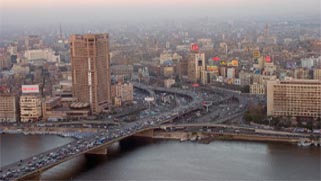|
|

| |
| |
Colossi Memnon |
| |
Eighteenth dynasty
The mortuary temple complex of Amenophis III in Thebes, the largest single temple ever build in Egypt, was the crown of his extraordinary architectural achievements.
Nothing now remains of that monumental structure which has been almost entirely destroyed by earthquakes and stone robbery apart from the two gigantic seated figures of the ruler known as the colossi of Memnon each worked from a single monolithic quartzite block , they reach a height of some 59 ft . The figures owe their name to a natural phenomenon. An earthquake in the year 27 B.C severely damaged the northern colossus and it subsequently began to sing in the morning. these sounds probably caused by the difference between the day time and night time temperature causing particles of stone to splinter off , were interpreted in antiquity as the lament of the goddess or her son memnon , who fell at the siege of troy . When the roman emperor septimius Severus had the figure restored in 199 A.D, it fell silent again forever |
| |
| |
|
| |
|
The
Ramesseum |
|
| |
The Ramesseum
Nineteenth Dynasty
Only a short time after Ramesses II came to the throne, work began on his great mortuary temple, the ramesseum the temple itself and an extensive complex of storerooms with barrel vaulting some of it well preserved occupy a surface area of roughly 161,548 ft. Beyond the mightily pylon at the entrance, the first in mortuary temple architecture to be built of sandstone. Lay two courtyards containing several colossal figures of the ruler.
Three parallel ramps then lead from the second courtyard to the elevated temple building and the visitor reaches the great hypostyle hall, in its basilica style of building with 48 papyrus columns in all, it reflects the hypostyle hall of the temple of Karnak. The following room has a ceiling with depictions of astronomical subjects and there are pictures of the barque procession on the east wall. Next is the space of the so-called offering hall. However the sanctuary area itself has been completely destroyed
One of the largest colossal figures of the deified Ramesses, to which this name was given, rose south of the ramp leading up from the first courtyard to the second pylon. The enormous remains of this seated statue still fascinate us today. It once reached a height of over 60 ft. and weighted more than 1000 tones. The individual measurements of the carefully worked gigantic statue are impressive too |
 
|
| |
| |
| |
| |
 |
The
Karnak Temple
In ancient Egypt, the power of the god Amun of Thebes gradually increased during the early New Kingdom, and after the short persecution led by Akhenaten, it rose to its apex. In the reign of
Ramses III, |
 |
|
|
|
 |
The Valley of the Kings
The tombs of the
Valley of the Kings originally contained many other
items that were transferred to the Egyptian Museum
like the royal belongings of the king that he will
use in the afterlife |
 |
|
| |
 |
The Queen Hatshepsut Temple
In a spot sacred to the goddess Hathor in the West Bank of Luxor, situated under the foot of one of the huge Theban Mountains, the Queen Hatshepsut has built her mortuary temple that was so fascinating that was called many names in ancient times |
 |
|
| |
 |
The colossi of Memnon
The Colossi of Memnon. One of the main attractions on the West Bank of Luxor, a landmark which everyone passes on the road to the monument |
 |
|
| |
 |
The
Luxor Temple
Located in the heart of the modern city of Luxor, the Luxor temple, especially the two colossi of Ramses II situated at the entrance of the temple, has become a land mark of the city. |
 |
|
|
| |
 |
 |
 |
 |
 |
 |
 |
Discover Luxor
Do you have plans to travel to Egypt?
A comprehensive Egypt travel offer – of every type, destination and period in Egypt! In addition, |
Luxor Attractions
Luxor attractions and sightseeing attractions in
Luxor . Book Luxor attraction tours
with Select Egypt |
Luxor Holidays
special discount holiday packages offers for
Luxor travel. We give you tailor made holiday deals for
Luxor travel |
Luxor Tours & Excursions
special discount holiday packages offers for
Luxor excursions. We give you tailor made holiday deals for
Luxor travel |
| Read More >> |
Read More >> |
Read More >> |
Read More >> |
|
| |
 |
| |
 |
 |
 |
 |
 |
Luxor Hotels
Choose from over 89
Luxor hotels with huge savings. Whatever your budget, compare prices and read reviews for all our
Luxor hotels |
Luxor Map
Luxor was constructed on the ruins of the ancient city of Thebes, the capital of Egypt during the Pharaonic New Kingdom (1550 – 1069 BC). |
Luxor Monuments
The best monuments of
Luxor . Information about Luxor monuments, landmarks, historic buildings and museums in
Luxor |
| Read More >> |
Read More >> |
Read More >> |
|
| |
|
|
|